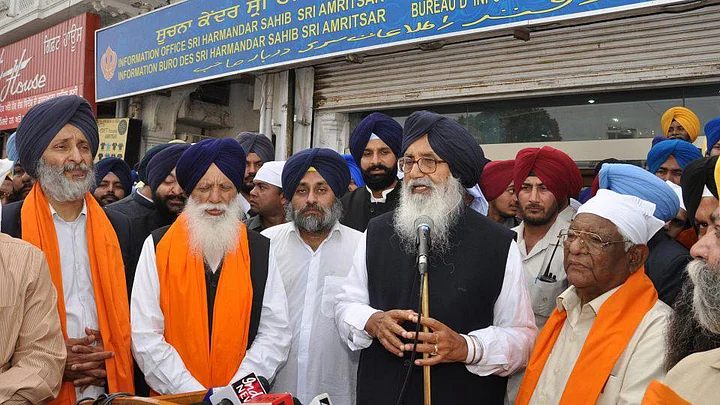Speakers at the massive sadbhavna rally organised by the Shiromani Akali Dal in association with the BJP, near Bathinda on the eve of the martyrdom day anniversary of Guru Tegh Bahadur (on November 24) harked back to the ideals for which the guru had embraced martyrdom. The ninth guru, who had vowed to protect Kashmiri pundits from forced conversions, and had himself refused to convert to Islam, was ordered to be beheaded by Aurangzeb at the age of 54.
Punjab Chief Minister
Parkash Singh Badal and his daughter-in-law, Union minister Harsimrat Kaur
Badal, referred to the life and teachings of the guru to highlight the
atrocities committed by Sikh extremists during the dark days of militancy. They
pointed out that those behind the militancy were again attempting to stoke
communal fire and were responsible for the recent incidents of sacrilege and
revival of demand for Khalistan.
The senior Badal even quoted a slogan used by the terrorists which implied that
they would behead all non-Sikhs. He said their stand and action was totally
contrary to what the Sikh gurus stood for and taught.
Sadbhavna Rally, A Political Opportunity
- The sadbhavna rally,
first of a series organised by the SAD, a show of strength by Sukhbir
Singh Badal
- Rally a litmus test for Sukhbir in the wake
of recent agitation by farmers and others
- November 10 Sarbat Khalsa (Sikh congregation) presents
another challenge for the state government due to its secessionist agenda
- Sarbat Khalsa’s participants
included leaders from BSP, AAP and even the Congress
- To counter
political insinuations of any kind, SAD’s sadbhavna
rally saw Sukhbir asserting himself as he declared party’s campaign for 2017
polls
Sukhbir’s Litmus Test
The sadhbhavna rally, first of a series planned to be organised by the SAD, turned out to be a show of strength by the party president and Deputy Chief Minister Sukhbir Singh Badal. The junior Badal was justifiably upbeat in view of the rally attendance. It was a litmus test for him and the party in the shadow of a recent mass upsurge against the government by farmers and other sections of the society.
The farmers’ protests was
sparked by the failure of the cotton crop due to a scam involving fake
pesticides and spread after the Sikh clergy pardoned Dera Sacha Sauda chief
Gurmeet Ram Rahim Singh under dubious circumstances.
The agitation gathered momentum after a series of acts of desecration and
sacrilege when angs (pages) of the Guru Granth Sahib were
found torn and scattered in about a dozen villages. It was certain by that time
that these were deliberate attempts by mischievous elements to disturb the peace
in the state.
Deliberate Acts of Desecration
The deliberate desecration
was the handiwork of those who claimed to be the protectors of the Sikh faith.
Among those charged and arrested were Sikh priests and those backed by a
section of the diaspora. The culprits are likely to be brought to book by the CBI
which has been entrusted with to probe.
The culprits also stood exposed at the November 10 Sarbat Khalsa (Sikh
congregation). The radicals evidently hijacked the convention and in thinly
veiled resolutions sought to impose their secessionist agenda. They ‘appointed’
former terrorists, including Beant Singh assassination convict Jagtar Singh
Hawara, as head priests. Hawara is serving life term in Tihar.
It is now clear that large sections of people who participated in the Sarbat
Khalsa, which remains disputed due to the manner in which it was called, did
not take well to the “unanimous resolutions” passed at the convention. In fact,
the participants included some leaders of the Bahujan Samaj Party, Aam Aadmi
Party (AAP) and even the Congress. They took the plea that it was supposed to
be a non-political meeting and that they participated in it as Sikhs.
No Support of Secession
The fact that there is no groundswell of support for the secessionist agenda, or any sympathy for the radical leaders, was proved when those who organised the Sarbat Khalsa were arrested and booked for sedition. There was not even a whimper of protest from the thousands who attended the congregation and the call given by the leaders to boycott the SAD’s sadbhavna rally also received practically no response.
To call for a massive rally at this juncture, when several Akali leaders were heckled and not allowed to speak, was undoubtedly a brave decision by the SAD. Sukhbir’s crowd mobilisation and management skills paid off even though the opposition alleged that the state machinery was used and people were “forced” to participate. Pleased with the gathering at the rally, Sukhbir declared his party’s campaign for the February 2017 assembly elections.
His father and wife, who referred to the sacrifices made by Guru Tegh Bahadur for communal harmony and human rights, also appealed to the people to celebrate the forthcoming birth anniversary of the first guru, Guru Nanak, on November 25, while criticising the call given earlier by the radicals to observe a ‘Black Diwali’ which also coincides with the ‘Bandichor Diwas’.
(The writer is a Chandigarh-based senior journalist)
(At The Quint, we question everything. Play an active role in shaping our journalism by becoming a member today.)
